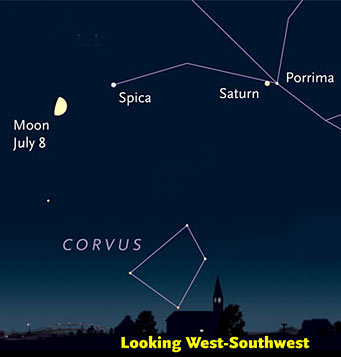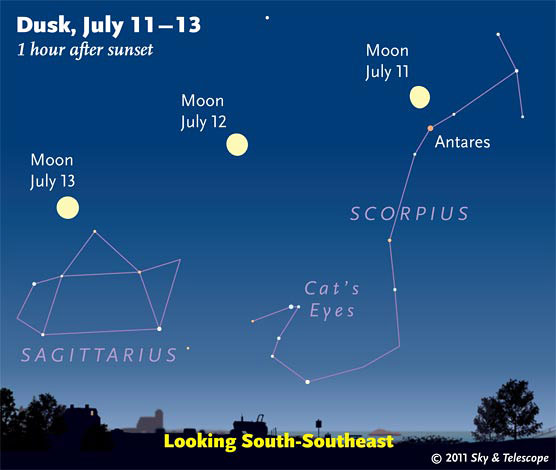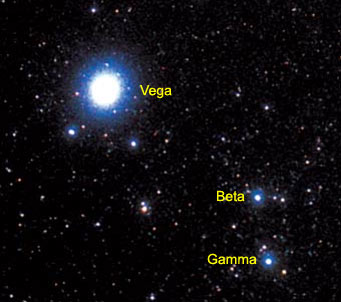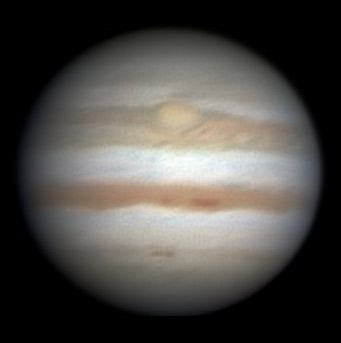M51 Supernova update. The supernova in M51 (the Whirlpool Galaxy) has faded to about magnitude 13.6 as of July 7th, but its fading has slowed. It's still visible in large amateur telescopes although moonlight is becoming a problem; the earlier in the week you try for it the better.
Here's an up-to-date light curve from the AAVSO. See our original article with finder photo.

On Friday evening, the Moon is just past first quarter.
Sky & Telescope diagram
Friday, July 8
Saturday, July 9
Sunday, July 10
Monday, July 11

The Moon crosses Scorpius and Sagittarius as it waxes to full. In these scenes, the Moon is always placed for an observer in the middle of North America. European skywatchers: move each Moon symbol a quarter of the way toward the one for the previous date. The Moon is shown three times its actual apparent diameter.
Sky & Telescope diagram
Tuesday, July 12
Wednesday, July 13
Thursday, July 14

The little constellation Lyra dangles below Vega these evenings. For much of the time, Beta Lyrae is almost exactly as bright as Gamma. However. . . .
Akira Fujii
Friday, July 15
Saturday, July 16
Want to become a better amateur astronomer? Learn your way around the constellations. They're the key to locating everything fainter and deeper to hunt with binoculars or a telescope.
For an easy-to-use constellation guide covering the whole evening sky, use the big monthly map in the center of each issue of Sky & Telescope, the essential magazine of astronomy. Or download our free Getting Started in Astronomy booklet (which only has bimonthly maps).

The Pocket Sky Atlas plots 30,796 stars to magnitude 7.6 — which may sound like a lot, but that's less than one star in an entire telescopic field of view, on average. By comparison, Sky Atlas 2000.0 plots 81,312 stars to magnitude 8.5, typically one or two stars per telescopic field. Both atlases include many hundreds of deep-sky targets — galaxies, star clusters, and nebulae — to hunt among the stars.
Sky & Telescope
Once you get a telescope, to put it to good use you must have a detailed, large-scale sky atlas (set of charts). The standards are the Pocket Sky Atlas, which shows stars to magnitude 7.6; the larger Sky Atlas 2000.0 (stars to magnitude 8.5); and the even larger and deeper Uranometria 2000.0 (stars to magnitude 9.75). And read how to use sky charts effectively.
You'll also want a good deep-sky guidebook, such as Sky Atlas 2000.0 Companion by Strong and Sinnott, or the more detailed and descriptive Night Sky Observer's Guide by Kepple and Sanner, or the classic if dated Burnham's Celestial Handbook.
Can a computerized telescope take their place? I don't think so — not for beginners, anyway, and especially not on mounts that are less than top-quality mechanically. As Terence Dickinson and Alan Dyer say in their Backyard Astronomer's Guide, "A full appreciation of the universe cannot come without developing the skills to find things in the sky and understanding how the sky works. This knowledge comes only by spending time under the stars with star maps in hand."
This Week's Planet Roundup
Mercury (magnitude 0.0) remains very low in the west-northwest in twilight. Don't confuse it with Regulus well to its upper left. Mercury and Regulus will pass 3° apart on July 26th.
Venus is disappearing deep into the glow of sunrise.
Mars (magnitude +1.4, in Taurus) is moderately low in the east-northeast as dawn begins to brighten. Look for it very far lower left of bright Jupiter. To the right of Mars (by 6° to 10°: this week) is Aldebaran, similar in brightness and color.
In a telescope Mars is still just a tiny blob only 4.3 arcseconds in diameter. It's on its way to a poor opposition (13.9 arcseconds wide) next March.

Jupiter is coming into better view now in the dawn, but it's still very far from its best. Christopher Go obtained this fine stacked-video image on June 8th. Jupiter's dark South Equatorial Belt (above center) has fully returned and is very wide. The narrower North Equatorial Belt remains darker red-brown, with even darker barges. At the time of the photo the Great Red Spot had just barely passed the planet's central meridian (where the System II longitude was 163°). The SEB practically encompasses the Red Spot, and the Red Spot Hollow around the spot has changed from white to dark. South is up.
Jupiter (magnitude –2.3, in southern Aries) rises around 1 or 2 a.m. daylight saving time and shines high in the east by dawn.
Saturn (magnitude +0.9, in Virgo) is southwest after dusk and sinking lower. Shining 14° left of it is similar, but bluer, Spica. And about 1° to Saturn's right is fainter Porrima (Gamma Virginis), still forming a striking pair with it.
In a telescope, Saturn's rings are 7.6° from edge on. The rings are casting their shadow southward onto the globe as a thin black line. The globe's shadow on the rings is just off the globe's celestial east (following) side. The North Equatorial Belt is a dusky band. Identify the Saturnian satellites visible in your telescope with our Saturn's moons tracker.
Uranus (magnitude 5.9, in western Pisces) and Neptune (magnitude 7.9, in western Aquarius) are about equally high now before the very first light of dawn, in the southeast and south, respectively. Neptune is having its first birthday this week, at least from the human point of view; see July 12 above. Here's our printable finder chart for both planets.
Pluto (magnitude 14.0, in northern Sagittarius) is highest in the south around midnight. A big finder chart for it is in the July Sky & Telescope, page 64.
All descriptions that relate to your horizon — including the words up, down, right, and left — are written for the world's mid-northern latitudes. Descriptions that also depend on longitude (mainly Moon positions) are for North America. Eastern Daylight Time (EDT) equals Universal Time (also known as UT, UTC, or GMT) minus 4 hours.
To be sure to get the current Sky at a Glance, bookmark this URL:
http://SkyandTelescope.com/observing/ataglance?1=1
If pictures fail to load, refresh the page. If they still fail to load, change the 1 at the end of the URL to any other character and try again.
 0
0
Comments
You must be logged in to post a comment.